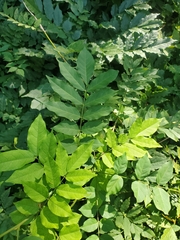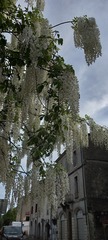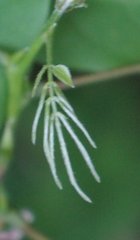Wisteria floribunda: taxon details and analytics
- Domain
- Kingdom
- Plantae
- Phylum
- Tracheophyta
- Class
- Magnoliopsida
- Order
- Fabales
- Family
- Fabaceae
- Genus
- Wisteria
- Species
- Wisteria floribunda
- Scientific Name
- Wisteria floribunda
Summary description from Wikipedia:
Wisteria floribunda
Wisteria floribunda, common name Japanese wisteria (藤, fuji), is a species of flowering plant in the family Fabaceae, native to Japan. (Wisteriopsis japonica, synonym Wisteria japonica, is a different species.) Growing to 9 m (30 ft), Wisteria floribunda is a woody, deciduous twining climber. It was first brought from Japan to the United States in the 1830s. It is a common subject for bonsai, along with Wisteria sinensis (Chinese wisteria).
Japanese wisteria sports the longest flower racemes of any wisteria; Some of those cultivars can reach 2 m (7 ft) in length. These racemes burst into clustered white, pink, violet, or blue flowers in early- to mid-spring. The flowers carry a fragrance similar to that of grapes. The early flowering time of Japanese wisteria can cause problems in temperate climates, where early frosts can destroy the coming years' flowers. It will also flower only after passing from juvenile to adult stage, a transition that may take many years just like its cousin Chinese wisteria.
Japanese wisteria can grow over 30 metres (98 ft) long over many supports via powerful clockwise-twining stems. The foliage consists of shiny, dark-green, pinnately compound leaves 10–30 centimetres (3.9–11.8 in) in length. The leaves bear about 15-19 oblong leaflets that are each 2–6 centimetres (0.79–2.36 in) long. It also bears poisonous, brown, velvety, bean-like seed pods 5–10 centimetres (2.0–3.9 in) long that mature in summer and persist until winter. Japanese wisteria prefers moist soils and full sun in USDA plant hardiness zones 5–9. The plant often lives over 50 years.
...Wisteria floribunda in languages:
- Czech
- wistárie květnatá
- English
- Japanese wisteria
- French
- Glycine du Japon
- German
- Japanischer Blauregen
- Japanese
- フジ
- Korean
- 등나무
- Polish
- Glicynia japońska
- Polish
- Glicynia kwiecista
- Polish
- Słodlin japoński
- Polish
- Wisteria japońska
- Russian
- Глициния обильноцветущая
- Slovak
- vistéria kvetnatá
- Swedish
- japanskt blåregn
Images from inaturalist.org observations:
We recommend you sign up for this excellent, free service.
Parent Taxon
Sibling Taxa
Child Taxa
Top Observation Places
- Susono
- Briarwood
- Kamakura
- Zushi
- Cherry Hill
- South Boston
- Brookline
- Redwood City
- Palo Alto
- Staten Island
- Berkeley
- Chattanooga
- Cheonan
- Manhattan
- Washington Heights
- Astoria
- Harlem
- East Harlem
- Fordham
- East Village
- Morningside Heights
- Mott Haven
- Tokyo
- Nakano
- Fuchū
- Chōfu
- Kamirenjaku
- Tama
- Musashino
- Niagara Falls
- Seosan
- Washington
- Arlington
- Alexandria
- Silver Spring
- Rockville
- Bethesda
- Reston
- Paterson
- Edison
- Irvington
- New Brunswick
- Union
- Piscataway
- Plainfield































































































































































